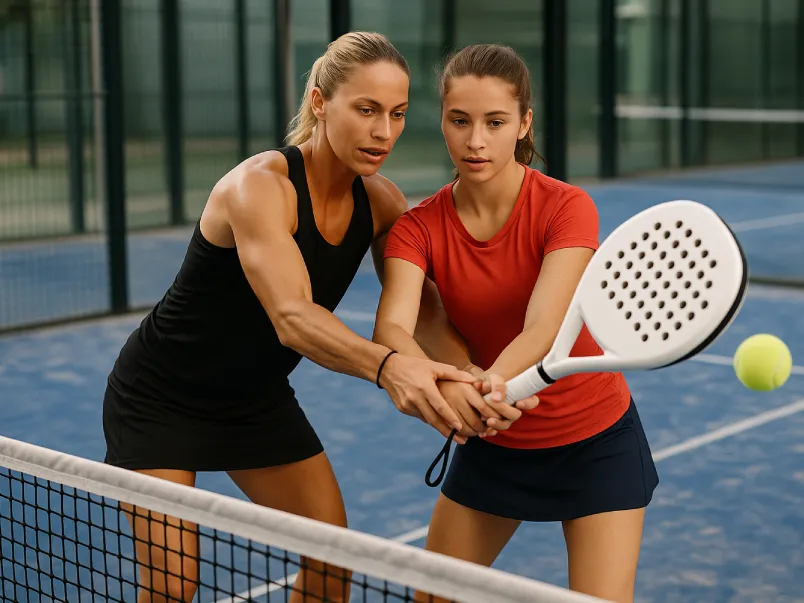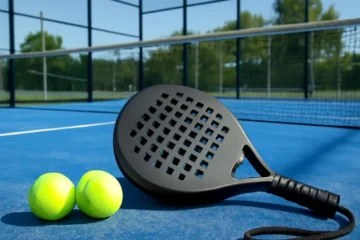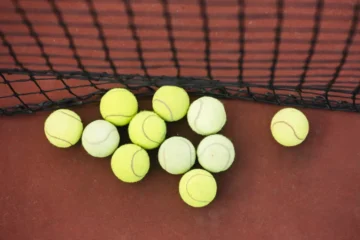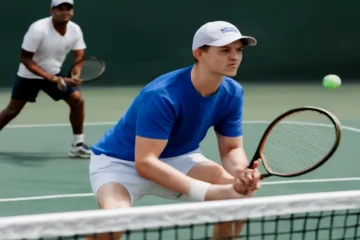Hook: The Myth of Natural Talent
When you watch a professional padel player glide across the court with ease, effortlessly executing powerful smashes and surgical volleys, it’s easy to believe that they are just born with natural talent. This misconception is rampant, especially among newcomers to the sport. However, the truth is far different. The excellence you see from the pros isn’t just the result of innate skill—it’s the product of a highly structured, disciplined, and multi-faceted training routine. These players have honed their craft over countless hours of dedicated practice in physical, technical, tactical, and mental domains.
Thesis: Training Smarter, Not Harder
Training like a pro isn’t about simply playing more; it’s about training smarter. Professionals approach their development with a clear, structured plan that spans across multiple facets of their game. To become a top-tier padel player, you must combine intensity with strategy in every area: your physical conditioning, your technical proficiency, your tactical awareness, and your mental toughness.
Promise to the Reader: Unlock Your Full Potential
This article will break down the key components of a professional padel player’s training routine, providing a blueprint you can adapt to your own journey. Whether you’re just starting or looking to elevate your game to the next level, following these principles will help you develop into a well-rounded, high-performing athlete.
Part 1: The Pro Mindset – It’s More Than Just a Game
1.1 Discipline Over Motivation
While motivation comes and goes, discipline is what separates the pros from the rest. Elite players don’t always feel like training, but they understand that consistency is key to long-term success. Training, no matter the mood, is non-negotiable. Developing the discipline to train even when motivation is low is essential to achieving excellence. Consistency in your training sessions and recovery routines ensures that progress is being made every day, even on the days when it feels hard to get started.
1.2 Embrace the Learning Process
Professional athletes understand that growth is a continuous process. Every loss, every mistake, and every missed shot is not seen as a failure but as valuable data for improvement. The ability to stay objective and learn from setbacks is critical. A key mindset shift is to view mistakes as opportunities for growth. When you view challenges as stepping stones rather than obstacles, it becomes easier to stay motivated and improve faster.
1.3 Goal Setting
One of the main drivers of progress for professional padel players is the clarity that comes from setting clear, SMART (Specific, Measurable, Achievable, Relevant, Time-bound) goals. Setting both short-term and long-term goals helps keep players focused, motivated, and on track. Whether you’re working on improving a particular stroke or striving to increase your endurance, having a defined goal will guide your training and provide benchmarks for success.
Part 2: The Physical Pillar – Building an Athletic Machine
2.1 On-Court Conditioning
Padel is a fast-paced, high-intensity sport that requires rapid bursts of energy. High-Intensity Interval Training (HIIT) is perfect for mimicking the stop-start nature of a padel point. This type of training improves your cardiovascular fitness, stamina, and ability to recover quickly between rallies. Incorporating sprint intervals and agility exercises will also improve your on-court endurance and explosiveness.
Footwork and Agility Drills
Footwork is paramount in padel. Good positioning often makes the difference between winning and losing a point. On-court agility drills, such as ladder drills and cone drills, will improve your lateral movement, quickness, and ability to change directions quickly. These drills will help you get into the optimal position to strike the ball with precision.
2.2 Off-Court Strength & Power
Padel players require a strong and balanced body, so it’s crucial to focus on strength training. Compound movements like squats, lunges, and deadlifts build overall strength, while core stability exercises (e.g., medicine ball throws, Russian twists) improve your rotational power—vital for generating speed and power in your strokes.
Upper Body and Shoulder Strength
The upper body, particularly the shoulders, is key to generating powerful smashes, volleys, and viboras. Strengthening the shoulders and upper body muscles through exercises like push-ups, shoulder presses, and resistance band work will improve your power, endurance, and injury prevention.
2.3 Flexibility and Injury Prevention
Padel players put their bodies through a lot of stress, particularly with sudden lateral movements and overhead shots. Dynamic stretching before play helps warm up the muscles, while static stretching and foam rolling after training aid in recovery. Prioritizing rest and sleep is equally important to allow muscles to repair and prevent injuries. Regular flexibility training helps maintain range of motion and reduces the risk of muscle strains.
Part 3: The Technical Toolkit – Mastering the Fundamentals
3.1 The Wall is Your Best Friend
The wall is an excellent tool for improving your consistency and ball control. By practicing with the wall, you can work on your timing, reaction speed, and accuracy. It’s especially helpful for improving your forehand, backhand, and volleys. Dedicate time to drills that focus on control, ensuring that you can consistently hit accurate and reliable shots, even under pressure.
3.2 Stroke-Specific Drills
The Bandeja
The bandeja is one of the most important shots in padel. It’s a defensive shot that often transitions into an offensive opportunity. To master it, practice repetition to focus on consistency and depth rather than power. A well-executed bandeja should allow you to regain control of the point and set up a subsequent attack.
The Vibora
The vibora, or “viper shot,” is a weapon used for sharp angles and spin. Drills that emphasize the mechanics of this shot will help you generate the ideal amount of spin and power to place the ball in difficult spots for your opponent. With repetition, you can develop the muscle memory to execute the vibora with precision and consistency.
The Smash
The smash is the padel equivalent of a tennis serve—an offensive shot used to end the point. Practice different types of smashes (flat, sliced, and high) as well as their placement on the court. The ability to place the ball accurately and vary your smash can make a huge difference in your game.
X3 (Off-the-Glass Shots)
Using the walls for off-the-glass shots is a great way to improve your awareness and ability to read the ball. Practice hitting the ball against the wall and reacting quickly to where it bounces. This drill will improve your ability to anticipate your opponent’s shots and recover quickly.
3.3 The Volley & Net Game
The net game is where you can dominate points. Rapid-fire volley drills, in which you practice hitting volleys in quick succession, improve your reflexes and touch at the net. Developing fast hands and being aggressive when moving to the net will increase your chances of winning points at the net.
Part 4: The Tactical Brain – Playing Chess on the Court
4.1 Understanding Your Role in a Pair
Padel is a doubles game, so understanding your role on the court is crucial. Players typically fall into two categories: the net player (agresor) and the baseline player (defensor). The net player focuses on controlling the net and attacking, while the baseline player defends and sets up attacks. Understanding these roles and knowing when to transition between them is essential for effective team dynamics.
4.2 Match Strategy & Analysis
Pre-Match: Analyzing Opponents
Before every match, take time to analyze your opponents. Look for weaknesses and strengths. Do they have a weaker backhand? Are they quick around the net? Analyzing these factors helps shape your game plan and gives you a competitive edge.
In-Match: Adapting Your Game Plan
Being adaptable is crucial in padel. During a match, you may need to switch strategies based on your opponent’s behavior and your own performance. Knowing when to be patient and wait for the right moment to attack is as important as executing offensive shots.
Post-Match: Reviewing Footage
Post-match analysis is a key element in improving your tactical game. Review match footage to identify areas where you made mistakes or could have taken better decisions. This feedback loop helps refine your decision-making skills for future matches.
4.3 Mastering “The Game Within the Game”
Padel isn’t just about hitting the ball—it’s about creating pressure on your opponents, causing them to doubt themselves. Mastering the use of the walls, varying the pace, and controlling the center of the court (the “T”) are all tactics that can give you a psychological advantage.
Part 5: The Mental Game – The Inner Champion
5.1 Emotional Control
In padel, things don’t always go according to plan. Emotional control is crucial to staying focused during the highs and lows of a match. Learn techniques to manage frustration and maintain concentration after a bad point. Meditation, deep breathing, and mindfulness exercises can help you regain focus quickly.
5.2 Visualization
Visualization is a powerful mental tool used by top athletes. By mentally rehearsing your shots, strategies, and even game scenarios, you can build confidence and improve your performance. Picture yourself hitting perfect shots, executing your strategy, and staying composed under pressure.
5.3 Resilience & Composure
Handling pressure and bouncing back from setbacks are key traits of a professional player. Resilience allows you to keep fighting, even when the odds seem stacked against you. Composure, particularly in tight moments, is what distinguishes champions from the rest. Stay calm, stay focused, and trust in your training.
Part 6: Putting It All Together – A Sample Weekly Training Plan
Monday:
- Technical Session (Bandeja/Vibora focus)
- Strength Training (Lower Body & Core)
Tuesday:
- On-Court HIIT Conditioning
- Match Play (focus on a specific tactic)
Wednesday:
- Active Recovery (light cycling, extensive stretching)
- Mental Training (visualization)
Thursday:
- Technical Session (Net Game & Volleys)
- Strength Training (Upper Body & Power)
Friday:
- Tactical Session (drills with a partner)
- Wall Drills
Saturday:
- Official Match or High-Intensity Practice Match
Sunday:
- Rest
Conclusion
Recap
To train like a professional padel player, focus on five essential pillars: the right mindset, physical conditioning, technical mastery, tactical intelligence, and mental toughness. These elements combine to create a holistic approach to development, ensuring you progress as a well-rounded player.
Final Encouragement
Remember, progress is a marathon, not a sprint. It takes time, dedication, and consistency. Adopting even one or two of these pro habits will significantly elevate your game. Keep training, keep improving, and most importantly, enjoy the journey.
FAQs
1. What is the best way to improve my padel game?
To improve your padel game, you should focus on a balanced training routine that includes physical conditioning, technical drills, tactical awareness, and mental preparation. Training smarter with a structured approach, consistency, and discipline is key. Incorporating strength training, agility drills, stroke-specific practice, and mental exercises will help elevate your performance.
2. How often should I practice padel to get better?
To improve effectively, it’s important to practice consistently. Aim for at least 3-4 practice sessions per week, with a combination of technical drills, conditioning, and match play. Additionally, make sure to include rest and recovery days to avoid burnout and injury.
3. What are the most important physical exercises for padel players?
The most important physical exercises for padel players include High-Intensity Interval Training (HIIT), footwork and agility drills, strength training (particularly for the lower body and core), and flexibility exercises for injury prevention. Focusing on shoulder strength and rotational power is also essential for executing powerful smashes and viboras.
4. How can I improve my mental game in padel?
Improving your mental game involves emotional control, resilience, and visualization techniques. Practicing mindfulness, deep breathing, and focusing on maintaining composure during matches will help you stay focused under pressure. Visualization techniques—mentally rehearsing shots, strategies, and successful outcomes—can also boost confidence and performance.
5. What is a good weekly training plan for a padel player?
A balanced weekly training plan includes a mix of technical sessions, physical conditioning, mental training, and match play. For example:
- Monday: Technical Session + Strength Training
- Tuesday: HIIT Conditioning + Match Play
- Wednesday: Active Recovery + Mental Training
- Thursday: Net Game + Strength Training
- Friday: Tactical Session + Wall Drills
- Saturday: Official Match or Practice Match
- Sunday: Rest




